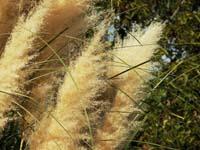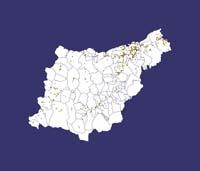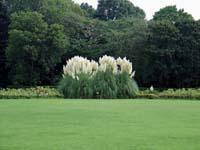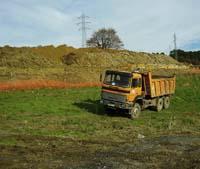Pampa shuttle: put on the map for disposal

Its scientific name is Cortaderia selloana, known as “carrizal de pampa”, “pampa” or “mustuka”. The scientific name is given by the sharp edges of the smaller ones, which cut it. Common names denounce other aspects of being: Native to South America, temperate region outside the tropics, it develops an inflorescence in the form of mustu when it blooms at the end of the smallest. This is precisely why it is such a well-known plant: in autumn an inflorescence occurs in the form of a whitish or pink feather, and then it appears more evident than ever.
Being so well known, anyone can affirm that in recent years there has been a spectacular increase in the float. It has gone from being exotic to being invasive. It is not the only one. In Euskal Herria, without being cultivated by man, they grow about four hundred strange vascular plants that appear spontaneously, both in natural environments and in human means. Of these, approximately one hundred have increased disproportionately, putting their habitat at risk. Cortaderia is one of those selloanas, one of the most dangerous in some places.
The pampas carrizo has adapted perfectly to the coastal humid lands and tends to form populations of high density. It covers mainly the lands that have been transformed by its easy colonization: edges of means of transport, slopes, new execution... However, its presence is becoming more and more frequent in unaltered habitats of great environmental value, such as wetlands, dunes, marshes, grasslands and scrublands, as well as juvenile plantations of radiata pine.
It produces various types of damage in occupied habitats. For example, in young forests and tree plantations, compete with young trees to absorb water and food, which slows down or hinders the growth of young trees. On the other hand, in summer, dry leaves and inflorescences increase the risk of fire. In grasses, on the contrary, it decreases the quality of the grass, decreasing the economic value of the grassland. It also implies the loss of biodiversity of the pastizal or meadow.

In areas of special interest or protection, it competes with the native vegetation, reaching its substitution, especially in humid zones. In addition, it disrupts the evolution of natural areas, slowing down the natural evolution towards afforestation. It finally affects the entire ecosystem.
From a social point of view, it reduces the aesthetic value of the environment and its recreational use, as well as the quality of the landscape. And the pollen it generates at the end of summer and beginning of autumn can produce allergies to people who live near the large colonies of pampas carricero.
First job, complete the map
Each inflorescence of the pampas carrizo produces one hundred thousand seeds and a single plant grows one million. They are detached from the plant tied to a long coat, which facilitates its transport. They are separated by more than thirty kilometers and arrive farther through the means of transport, the air currents that generate the vehicles, the surface of the vehicles, or of the pedestrians and clothes of the people.

The best lands to germinate seeds are abundant sand, water and shade, but they are also able to germinate in inadequate lands. Temperate temperatures favor it to be more abundant in the lower part of the valleys, where most of the towns and cities are located, where the means of transport pass.
The Provincial Council of Bizkaia published in 2006 a practical guide for the control of the runoff of pampas, which in the population map appears clearly represented: the main populations are located on the margins of the main roads and the highways, highlighting the highways A-8 and A-68 and the Txorierri motorway.
The mapping of the plant has now been carried out by the Sociedad de Ciencias Aranzadi, at the request of the Diputación Foral de Gipuzkoa, and they have found that in this territory the expansion of the reservoir of the pampas follows the same model. That is to say, the largest densities of population are concentrated in the proximities of Donostia-San Sebastian, beginning with Irun, and extends through the valleys following the main means of transport. The location of each population has been determined, paying special attention to natural spaces, very vulnerable and of great value.
Control measures: control measures
The elaboration of the map has been the first step. Now they must test the control measures to choose and launch the most appropriate in each case. Priority places will be lands with protected areas and high density populations.

The measures can be physical, chemical and others. The most selective is to start the plant. As is very abundant, a lot of workers would be needed to remove all the plants, something that is impossible here. However, in some places, groups of volunteers have been organized, who extract root plants by hand. It is an effective method in certain places, such as protected areas and small populations.
In high-density areas, machinery has been used for the extraction and destruction of plants, but it is not a good solution since the soil is bare, which facilitates the introduction of invasive plants (pampas carrizo or others). Other methods can be cutting with scythe, elimination of inflorescences and burning, although not effective.
In addition to physical methods, there are chemicals, i.e., herbicides. The majority use is glyphosate, since it is effective against the plant and little toxic for mammals, birds and fish. However, it cannot be used in any way since it is not selective and can be harmful to the vegetation of the area. Therefore, its use must be moderate and careful. For example, it can be injected into the plant itself, preventing it from reaching the ground and the living beings that surround it.
In addition, there is the possibility of sharing methods. Although in each case it is necessary to analyze what is most efficient, experts recommend that the best is to cut the plant (before the flowers are believed) and then give herbicide. Subsequently, the removal of the dead plants will be carried out.

In any case, it is not enough to remove the existing plants. Preventive measures are essential to prevent new colonizations. Among other things, it is advisable to properly plan road works and other constructions to minimize alteration of the land and quickly restore existing vegetation. In addition, vehicles must be cleaned properly before being used anywhere else. On the other hand, once the measures have been implemented, it is necessary to carry out a systematic and continuous monitoring of the populations.
In addition, experts point out the importance of educating society. People should know that this elegant plant harms the environment, does not have to be planted and should not contribute to its expansion. With all these measures they manage to eliminate them or at least prevent their diffusion.





